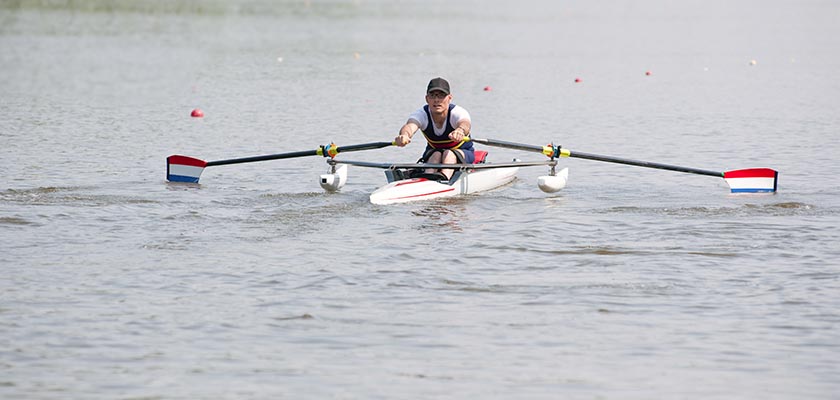Overcoming, inclusion and determination: three words that define Paralympic rowing, a sport adapted for athletes with physical or visual disabilities. In this sport, athletic ability and resilience stand out, inspiring participants and spectators around the world. In this article, you’ll find out all about Paralympic rowing: history, how it works, classifications and much more.
Participate in our free WhatsApp community and receive daily tips, news and trivia from over 50 sports! Click here to join.
How paralympic rowing works
Paralympic rowing (also called adapted rowing) follows similar principles to conventional rowing, but with some adaptations. The boats are equipped with special seats for athletes with physical disabilities or guide systems for athletes with visual impairments.
As with conventional rowing, Paralympic rowers compete in different categories, depending on their disability and functional capacity.
All about Paralympic rowing: events
In addition, the paralympic rowing events can vary in distance, but generally follow similar patterns to conventional competitions, including 1000m and 2000m races.
All about Paralympic rowing: skills
Paralympic rowing requires muscular strength and good endurance and the ability to apply force repeatedly throughout a race. Coordination is also essential to synchronize movements and ensure efficient rowing.
Another important point in the sport is keeping your balance in the boat – fundamental for avoiding accidents and ensuring smooth, effective paddling. A sense of balance and stability helps you cope with the waves and movements of the boat.
All about Paralympic rowing: history
The history of Paralympic rowing begins in the 1980s. The first international rowing competition for people with disabilities took place in 1988 in Seville, Spain, during the Summer Paralympic Games.
Initially, Paralympic rowing faced challenges in adapting boats and equipment to accommodate the specific needs of athletes with disabilities. But over time, there have been significant advances in technology and adaptation practices.
Paralympic Games
Paralympic rowing was officially included in the program of the Paralympic Games in 2008, in Beijing, China.
Today, Paralympic rowing is gaining more popularity and recognition every day, with an increasing number of countries investing in development and support programs for disabled athletes interested in taking part in the sport.
Paralympic rowing in Brazil
The beginning of the remo paralympics in Brazil was in the 1990s, with the creation of adaptation and training programs for athletes with physical and visual disabilities.
The role of making Paralympic rowing grow in the country was left in the hands of the Brazilian Paralympic Committee (CPB), with the support of local rowing clubs and federations.
Brazil began competing internationally in Paralympic rowing in the mid-2000s.
What is the difference between rowing and canoeing?
As two different sports, there is quite a difference between rowing and canoeing: in rowing, the boats are long and narrow, designed to minimize friction with the water and provide maximum speed. The boats used in canoeing, on the other hand, are shorter and wider, designed for greater stability and maneuverability.
In rowing, athletes use oars with blades at both ends to propel a boat. In canoeing, athletes use oars with a blade at only one end.
Another difference is in the technique used, since rowing involves coordinated movements using the lower and upper limbs. Athletes usually row seated and use a seat sliding system to optimize the reach and power of each stroke.

Has Brazil won in Paralympic rowing?
At the Beijing 2008 Paralympic Games, Brazil won its first medal in Paralympic rowing, a silver in the Mixed Double Skiff, with athlete Josiane Lima.
In 2016, in Rio de Janeiro, Brazil won bronze medals in both the men’s and women’s skiff, with athletes Rene Pereira and Josiane Lima, respectively.
The top 10 Paralympic rowers
The paralympic rowing athletes represent overcoming and inspire spectators all over the world. Check out the main ones:
1. Roman Polianskyi (Ukraine)
Gold medalist at the Paralympic Games and multiple world champion in several Paralympic rowing categories.
2. Nico Beeler (Switzerland)
Gold medalist at the Paralympic Games and world champion in several Paralympic rowing events.
3. Erik Horrie (Australia)
Silver and bronze medalist at the Paralympic Games, as well as world champion in different Paralympic rowing categories.
4. Rene Pereira (Brazil)
Bronze medalist at the 2016 Paralympic Games in Rio de Janeiro in the Men’s Single Skiff category.
5. Josiane Lima (Brazil)
Bronze medalist at the 2016 Paralympic Games in Rio de Janeiro in the Women’s Single Skiff category.
6. Laurence Whiteley (UK)
Gold medalist at the Paralympic Games and world champion in several Paralympic rowing categories.
7. Perle Bouge (France)
Gold medalist at the Paralympic Games and world champion in several Paralympic rowing events.
8. Annika van der Meer (Netherlands)
Gold medalist at the Paralympic Games and world champion in different Paralympic rowing categories.
9. Lohmann Bjoern (Germany)
Gold medalist at the Paralympic Games and world champion in several Paralympic rowing events.
10. Nikita Bolozin (Russia)
Gold medalist at the Paralympic Games and world champion in several Paralympic rowing categories.
See, now you’re a true expert and know everything about paralympic rowing. Follow the other content on our website and learn more and more about the world of sports:





